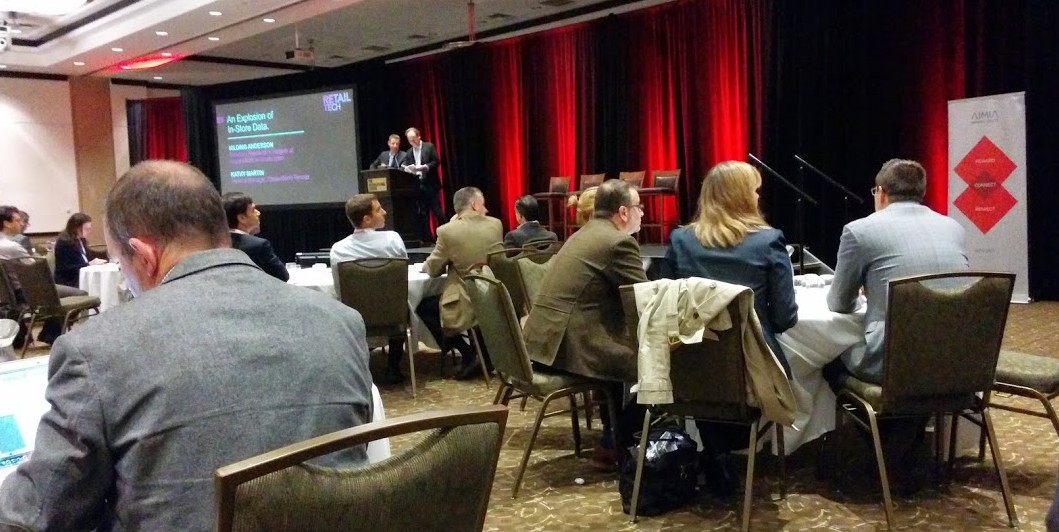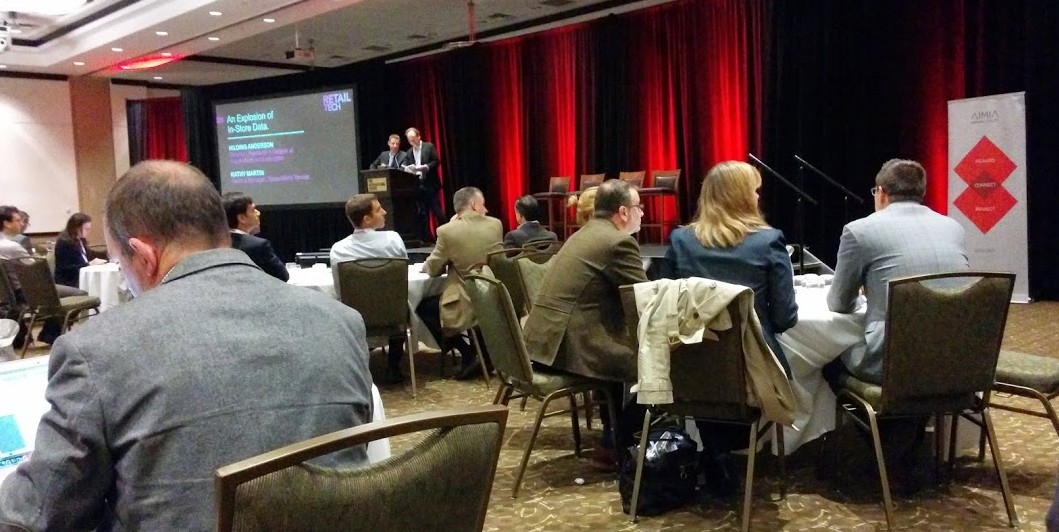
Retail Tech 14: Retailer Perceptions Of Mobile Use, And Reality, Quite Different
October 8, 2014 by Dave Haynes

I zipped around the outer fringe of Toronto this morning to get up near the airport in a timely way and catch the half-day Retail Tech Conference, which attracted an impressively well-stocked room full of retailers and agency people.
The event also had a healthy bunch of speakers, including folks from SapientNitro and from Google. All told, worth the drive and armed-robbery electronic toll road fee I’ll see in the mail in a few weeks.
I took a bunch of notes, but as I age the ability to read my handwriting gets even worse. When I was a print journalist, tape recorders were my best friends forever. Here’s some of what I am able to decode, and that I found interesting.
SapientNitro – big interactive agency owned by one of the monster agency holding groups – talked about some of its research on consumers and their real use of mobile in retail environments. What Sapient found was surprisingly different from what the retail industry thinks is happening:
First, the rule of thumb seems to be that shopping trip length averages 45 minutes. Their data shows 36 minutes.
Second, retailers are thinking shoppers spend 84% of their time in store doing something with digital devices. The data shows it is more like 12%.
Third, using shopping comparison apps in-store – aka showrooming – isn’t as pervasive as thought (sorry, can’t quite read the notes on numbers, sigh).
Finally, retailers think a lot of consumers come into stores armed with lists they loaded up on mobile apps. Turns out, that rarely happens.
Retail Foot Traffic Halved In Last 4 Years
A couple of other interesting things from SapientNitro:
The most compelling stat I’ve heard to date about online/mobile shopping – During the 2013 holiday shopping season, foot traffic to stores was down 50% in the U.S. from where it was in 2010. That’s 17 billion fewer shoppers.
Sapient’s Hilding Anderson stressed that doesn’t mean bricks and mortar retail is on an unstoppable slide, but it does mean the retailers who are going to prosper going forward need serious re-thinks about merchandising and the store experience.
That said, they noted a study of 72 retailers they ran in the US and Canada found only three were embracing and nailing in-store digital and another 15 were doing OK-ish. The rest, nope. Where it is being done, it works and shows an ROI. They cited Build-A-Bear – which saw 20%-30% same-store sales jumps when they want from conventional to digital.
Other notes:
The Google guy, Chris Hodgson, talked about how retailers need to come to grips with mobile, and he used the example of what would happen if a large retailer’s customer base all started routinely rolling up on motorcycles. The retailer, he argued, would start looking at adjusting all kinds of things, from the parking lot set-up to in-store tweaks. But, he argued, that’s the dramatic gravity of the change happening with mobile-armed consumers, and many retailers aren’t doing much at all to adjust.
Hodgson suggested “retailers need someone charged with ruthlessly going through the details of the customer experience.”
Promiscuous Shoppers
Duncan Stewart, of the mobile/retail analytics firm Aimia, talked about his company’s retail work, notably with Sainsbury’s in the UK. He noted how consumers, because of all the instant research tools and incentives available to them, have been trained to be more promiscuous about the way they shop. Meaning retailers have to work harder at loyalty.
He said his company’s experience, backed by data, suggests people don’t want to be carpet-bombed with offers when they are in and around stores. If it doesn’t resonate, he says, they’ll ignore it.”You want consumers to be active participants of the brand, not passive recipients.”
He noted how at Sainsbury’s, the coupon incentives are often done post-sale – with coupons issued with receipts that offer direct cash off on their next visit, or notes on receipts that say that the same purchase done at somewhere like the Tesco down the road would have cost XX pounds more, based on instant tabulations from the POS data and back-office data.
The last guy I had time to listen to talked about the rising phenomenon in grocery, globally, of click and collect. Online grocery shopping and delivery has been around for many years, but with things like refrigerated lockers at commuter rail stations (get off train, open locker, take groceries home, skip store), it’s getting very sophisticated.
How digital signage plays in click and collect, I don’t know – other than reminding consumers it exists and is worth trying.
A lot of us tend to live too much inside our little industry bubble. The more I go to conferences where the phrase digital signage never comes up, the more I realize how valuable it is to hit these events.



Dave, excellent work recounting the conference. Your last paragraph really sums it up. While the digital signage industry is certainly a great industry, many in it tend to be oblivious to where the action is and what’s getting the most attention. To put things in perspective, the digital signage industry is growing 8 -14% per year (depending on whose numbers you believe) while there are sectors in the mobile industry that are growing at 150+ percent and doing so off of a much larger base. Shoot, mobile advertising alone was just $450 million four years ago but will top $20 billion this year and is projected to reach nearly $70 billion by 2018.
The highest growth segment in mobile is directed at mobile-enabled online, in-store and social commerce (omni-channel mobile commerce). What you may have heard at your conference is that there is a massive convergence occurring between online order management systems and the in-store point of sale. The focus of these converged systems is on allowing consumers to shop anytime, anywhere from any device (the focus, however, is on mobile devices). There is also a major push to integrate marketing, payments, shopping and loyalty.
What’s driving this change? EMV mandates are requiring retailers to change their point of sale infrastructure by Oct 2015. Because of the innovations in mobile, (coupled with desire to stop the on-going theft of credit card & personal data), the impact of this once “in-store only” decision is now cascading to all channels (online, in-store and social) as retailers now have a reason to pursue a more unified, secure approach to commerce. This in turn is creating a ripple-down effect to the core infrastructure (payments, marketing, shopping, loyalty and services) that will be used to support it.
As budgets are redirected to replacing/upgrading core infrastructure to support mobile-enabled omni-channel commerce, this will have an impact on digital signage. The time to prepare a response is not when these events control the industry, but when the industry can control them.
Last week I posted the following on Digital Signage Today to allow the industry to test itself on this mobile commerce revolution: http://bit.ly/1pIrwvf The response? Crickets. Sad!!! Just Sad!!!
Digital signage providers need to be savvy and aware of what is occurring in mobile. Whether the industry likes to admit it or not, mobile is the industry’s largest competitor for buyer budget dollars and consumer attention.